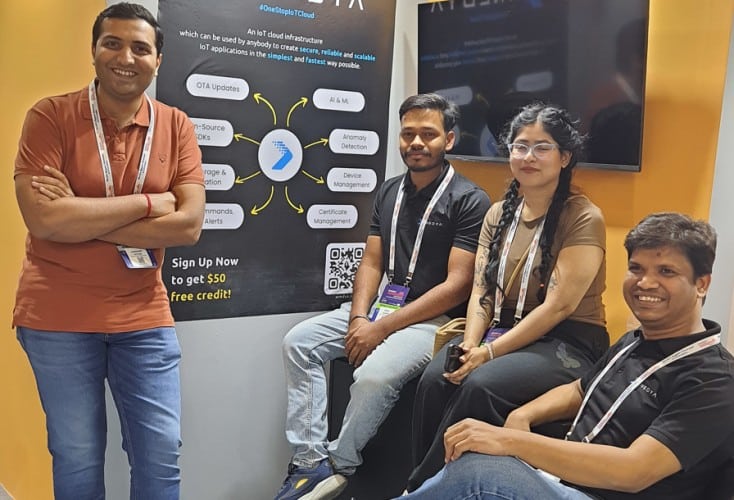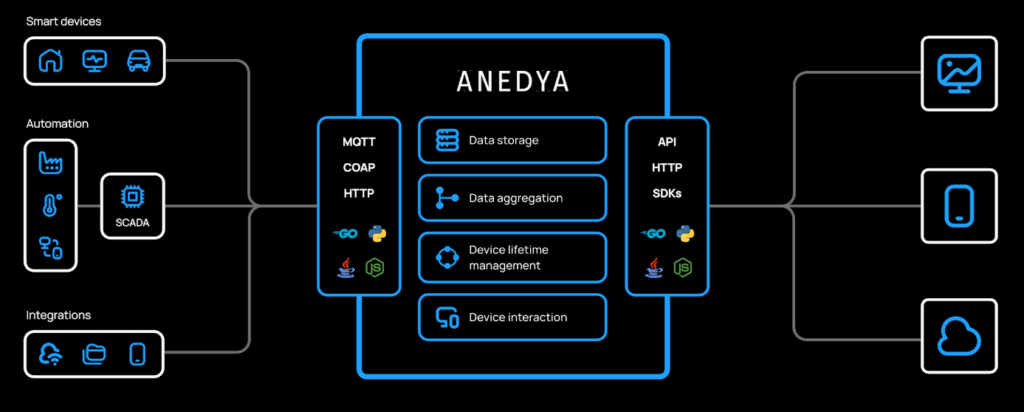
What if a conventional product could become an IoT-enabled device without the many months of development? Anedya Systems, an Ahmedabad-based startup, has this answer. The firm builders, Chinmaya Mahanta and Markand P Pathak, share with EFY’s Nitisha their journey of innovation, from hardware to cloud.
Q. What is Anedya?
A. Anedya simplifies the Internet of Things (IoT) by providing a dedicated cloud backend infrastructure layer tailored for IoT applications. This layer is offered as infrastructure-as-a-service (IaaS), helping clients quickly build, scale, and secure their IoT systems without needing to develop complex backend systems themselves.
Q. How does Anedya function?
A. We primarily serve original equipment manufacturers (OEMs) that manufacture a wide range of machines and products, including vehicles, smart home appliances, and industrial systems. For instance, if an EV manufacturer wants to make a smart connected vehicle, we help them transform their traditional products into IoT-enabled ones that can be tracked via mobile apps. This involves integrating IoT hardware (Wi-Fi or GSM chips), connecting to Anedya’s cloud platform, and a user interface. The core product is its cloud backend, built entirely in-house and designed to significantly reduce development time, often by six to seven months.
Q. What are the essential requirements to use Anedya in a product?
A. To integrate Anedya, the OEM must have hardware designed to be smart or connected. Once the hardware is ready, they need a scalable platform to manage devices, store and access data, send commands, update firmware over-the-air (OTA), and ensure robust security for potentially millions of devices. We handle all of this through our cloud platform, which offers scalability, data storage, control functionality, firmware updates, and security out of the box. OEMs simply sign up, connect their devices, and start using the service.

Q. Is everything developed in-house at Anedya?
A. Yes, as I said, all core technologies, including the message queuing telemetry transport (MQTT) broker, OTA system, and custom IoT database called Anedya ValueStore, are developed in-house.
Q. How does Anedya handle device provisioning at scale?
A. Devices can be pre-registered, self-registered, or registered through external interfaces, such as Wi-Fi or Bluetooth onboarding. Once registered, provisioning is handled automatically unless the device is reset or replaced. Furthermore, OEMs can integrate the provisioning process into their applications through our application programming interfaces (APIs). This allows flows where the end customer self-provisions devices without any assistance from OEM support staff.
Q. What security protocols does Anedya follow?
A. We do not allow unencrypted communication from devices at all. All device communications are encrypted using transport layer security (TLS) 1.2 or 1.3. Data at rest is encrypted with advanced encryption standard (AES)-256. We use custom-designed firewalls and behavioural monitoring to detect and block compromised devices. The company adheres to ISO and System and Organization Controls 2 (SOC 2) standards and is pursuing official certification.
Q. Do you offer SDKs and APIs for integration?
A. Yes, software development kits (SDKs) for popular platforms such as ESP and STM32 are open-source and available on GitHub. APIs with OpenAPI specifications and Postman collections are also provided for easy integration into firmware or apps.
Q. How is OTA firmware update handled?
A. Anedya’s OTA system enables developers to upload firmware, define target devices, and roll out updates in phases (such as five per cent, then 10 per cent, and finally 85 per cent). Devices securely pull update information from the cloud, download the binary, and update themselves based on hardware compatibility. This system extends beyond firmware, enabling the efficient and secure deployment of various assets, such as executables, media, or zip archives, across thousands of devices. It also supports versatile asset management, automatic aborts with rollback and full lifecycle tracking from deployment to installation.
Q. What is the latency for real-time commands and events?
A. We offer real-time command delivery with a latency of under 100 milliseconds (P95), ensuring fast and reliable control of connected devices.
Q. How does Anedya support data privacy and compliance?
A. We do not store any identifiable information. Devices are represented by random IDs. The platform provides APIs for data deletion, helping clients comply with regulations such as the General Data Protection Regulation (GDPR). The shared responsibility model allows OEMs to manage personal data separately.
Q. What level of analytics and visualisation does Anedya provide?
A. Standard data aggregation functions such as average, minimum, maximum, and moving averages are built-in. Visualisation is basic, as OEMs often develop their own front-ends. However, we are launching ‘Anedya Sparks’ – a feature that allows custom analytics and data processing.
Q. What innovations differentiate Anedya from competitors?
A. Anedya has built its own MQTT broker, a custom IoT database (Anedya ValueStore), a versatile OTA mechanism, and even its own public key infrastructure (PKI) to issue device TLS certificates. These in-house innovations reduce costs and increase performance, making Anedya a competitive global player.
Q. Is technical support and onboarding assistance available?
A. Absolutely. We provide technical support, onboarding guidance, and consultancy to help teams optimise application performance and reduce cloud costs.
Q. Can customers integrate Anedya with their existing infrastructure?
A. Yes, we provide APIs for data access and device control. These APIs can be integrated with existing mobile apps, cloud platforms, or any other services such as customer relationship management (CRM) or enterprise resource planning (ERP).
Q. How many users and use cases does Anedya have?
A. We support over 3000 users. More than 10 use cases have been built using Anedya’s stack, and over 25,000 IoT devices are currently in operation. A few notable use cases include smart streetlight management, cold storage, connected vehicles, industrial automation, medical devices, smart agriculture, and drone telematics.
Q. Where does Anedya generate its revenue from?
A. Revenue comes primarily from business-to-business (B2B) OEMs. We also offer a free tier for students and hobbyists, allowing experimentation and proof-of-concept development at no cost. This strategy enables broad adoption.
Q. What is the pricing model for Anedya services?
A. A pay-as-you-go model is followed. There are no upfront fees or subscriptions. Charges are based on the number of connected devices, data usage, and compute resources. On average, Anedya’s cost per device per year ranges from ₹10/year up to ₹200/year, depending on the IoT use case.
Q. How is Anedya helpful for students and startups?
A. We provide 100 devices free for a lifetime and $50 in credits to every user. The students are getting the most benefit out of it. They are able to learn IoT concepts by building their hobby or academic project. We also provide open-source project libraries for them. Further, to help startups who want to add IoT features in their products, we provide up to $1000 of credits after an evaluation.
Q. What challenges has Anedya faced in the IoT industry?
A. The major challenge is the complexity of IoT technology. Building a secure and scalable backend requires deep engineering knowledge. Hiring skilled developers with a strong fundamental understanding is also a challenge.
Q. What kind of vendors or partners is Anedya seeking?
A. We are building a partner network with hardware developers and system integrators who can utilise Anedya’s cloud infrastructure to develop and deploy IoT applications for global OEMs.
Q. Does Anedya hold any patents?
A. We have developed proprietary algorithms. However, India does not permit algorithmic patents. We are in the process of filing for patents internationally through the Patent Cooperation Treaty (PCT) process to secure our innovations.
Q. What are Anedya’s future plans?
A. We plan to expand globally by setting up subsidiaries, hiring regional sales teams, obtaining certifications such as GDPR and SOC 2, and investing in research and development. We also plan to grow through partnerships with hardware developers and system integrators.










